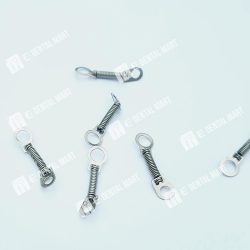Description
🦷 Uses of a Traction Hook:
-
Eruption of Impacted Teeth:
-
Commonly used to apply force to erupt impacted canines or premolars after surgical exposure.
-
A chain or elastic is attached from the impacted tooth to the hook on the archwire.
-
-
Attachment for Elastics:
-
Serves as a secure anchor point for interarch elastics (e.g., Class II, Class III, or crossbite elastics) to correct jaw relationships and occlusion.
-
-
Surgical Orthodontic Traction:
-
Used before or after orthognathic surgery to guide tooth or jaw movement with elastics, often combined with temporary anchorage devices (TADs).
-
-
Space Closure or Tooth Movement:
-
Helps in pulling teeth into alignment (e.g., closing extraction spaces, shifting molars or canines) by attaching elastics or coil springs.
-
-
Mini-Screw (TAD) Force Application:
-
Acts as a connecting point between the archwire and a temporary anchorage device, enabling complex or precise movements like intrusion or retraction.
-
✅ Benefits of a Traction Hook:
-
Precise Force Application
– Allows orthodontists to apply targeted, controlled force to specific teeth, improving treatment accuracy. -
Helps Erupt Impacted Teeth
– Facilitates the guided eruption of impacted canines, premolars, or other teeth, avoiding extractions. -
Supports Complex Tooth Movements
– Enables movement in multiple directions (intrusion, extrusion, retraction) when combined with elastics or auxiliaries. -
Improves Treatment Efficiency
– Reduces the need for more invasive procedures by using mechanical traction to move teeth gradually. -
Versatile with Other Appliances
– Works well with elastics, power chains, coils, and TADs, allowing for customizable biomechanics. -
Enhances Anchorage Control
– Provides stable attachment points, improving anchorage and reducing unwanted tooth movement. -
Aids in Surgical-Orthodontic Cases
– Used before and after jaw surgery to stabilize bite and ensure proper post-op tooth alignment.
🔩 Features of a Traction Hook:
-
Attachment Point for Force Application
– Designed to connect elastics, chains, or springs to apply directional orthodontic forces. -
Small and Low-Profile Design
– Minimally bulky, allowing for patient comfort and easier oral hygiene maintenance. -
Crimpable or Pre-Welded Options
– Available as crimpable hooks (attached directly to archwires) or pre-welded hooks (included in wire setup). -
Bondable Variants
– Some are bondable buttons or hooks that attach directly to the tooth surface, useful in cases like impacted canines. -
Compatible with Various Appliances
– Works with archwires, brackets, TADs, and chains, offering flexible integration into treatment mechanics. -
Made from Biocompatible Materials
– Typically crafted from stainless steel or titanium, ensuring strength, durability, and oral safety. -
Positioned for Custom Force Direction
– Can be placed anteriorly, posteriorly, or surgically to control force direction as needed for specific cases.











Reviews
There are no reviews yet.